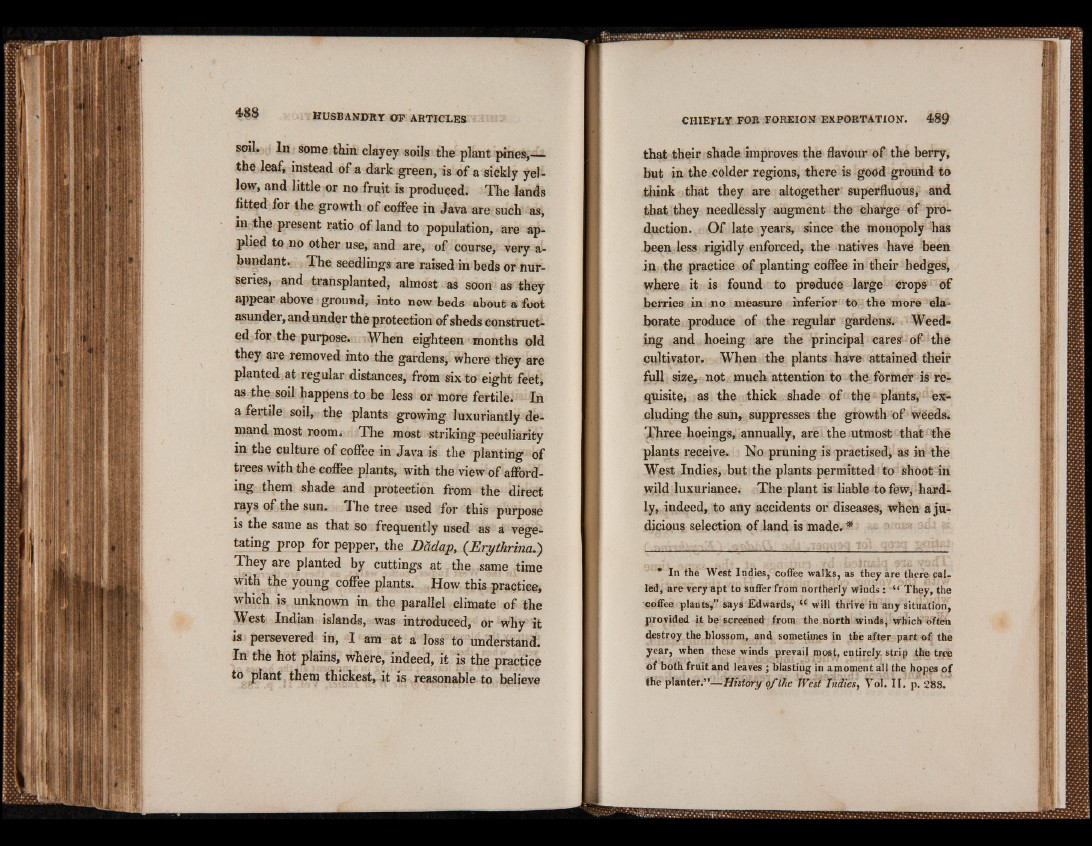
soil. In some thin clayey soils the plant pines,-—-
the leaf, instead of a dark green, is of a sickly yellow,
and little or no fruit is produced. The lands
fitted for the growth of coffee in Java are such as,
in the present ratio of land to population, are applied
to .no other use, and are, of course, very a-
bundant. The seedlings are raised in beds or nurseries,
and transplanted, almost as soon as they
appear above ground, into new beds about a foot
asunder, and under the protection of sheds constructed
for the purpose. When eighteen months old
they are removed into the gardens, where they are
planted , at regular distances, from six to eight feet,
as the soil happens to be less or more fertile; In
a fertile soil, the plants growing luxuriantly demand
most room. The most striking peculiarity
in the culture of coffee in Java is the planting of
trees with the coffee plants, with the view of affording
them shade and protection from the direct
rays of the sun. The tree used for this purpose
is the same as that so frequently used as a vegetating
prop for pepper, the Dddap, (Erythrina.')
They are planted by cuttings at the same time
with the young coffee plants. How, this practice,
which is unknown in the parallel climate of the
West Indian islands, was introduced, or why It
is persevered in, I am at a loss to understand.
In the hot plains, where, indeed, it is the practice
to plant them thickest, it is reasonable to believe
that their shade improves the flavour of the berry,
but in the colder regions, there is good ground to
think that they are altogether superfluous, and
that they needlessly augment the charge of production.
Of late years, since the monopoly has
been less rigidly enforced, the natives have been
in the practice of planting coffee in their hedges,
where it is found to produce large crops of
berries in no measure inferior to the more elaborate
produce of the regular gardens. Weeding
and hoeing are the principal cares of thé
cultivator. When the plants have attained their
full size, not much attention to the former is requisite,
as the thick shade of the plants, excluding
the sun, suppresses the growth of weeds.
Three hoeings, annually, are the utmost that thé
plants receive. No pruning is practised, as m the
West Indies, but the plants permitted to shoot in
\yild luxuriance, The plant is liable to few, hardly,
indeed, to any accidents or diseases, when a judicious
selection of land is made. *
* In the West Indies, coffee walks, as they are there called,
are very apt to snffer from northerly winds : “ They, the
coffee plants,” says Edwards, i( will thrive in any situation,
provided it be screened from the north winds, which often
destroy the blossom, and sometimes in the after part of the
year, when these winds prevail mosf, entirely strip the tree
of both fruit and leaves j blasting in amoment all the hopes of
the planter.”2l/f/sfdrjy qfthe West Indies^ Vol. I I. p. 288.